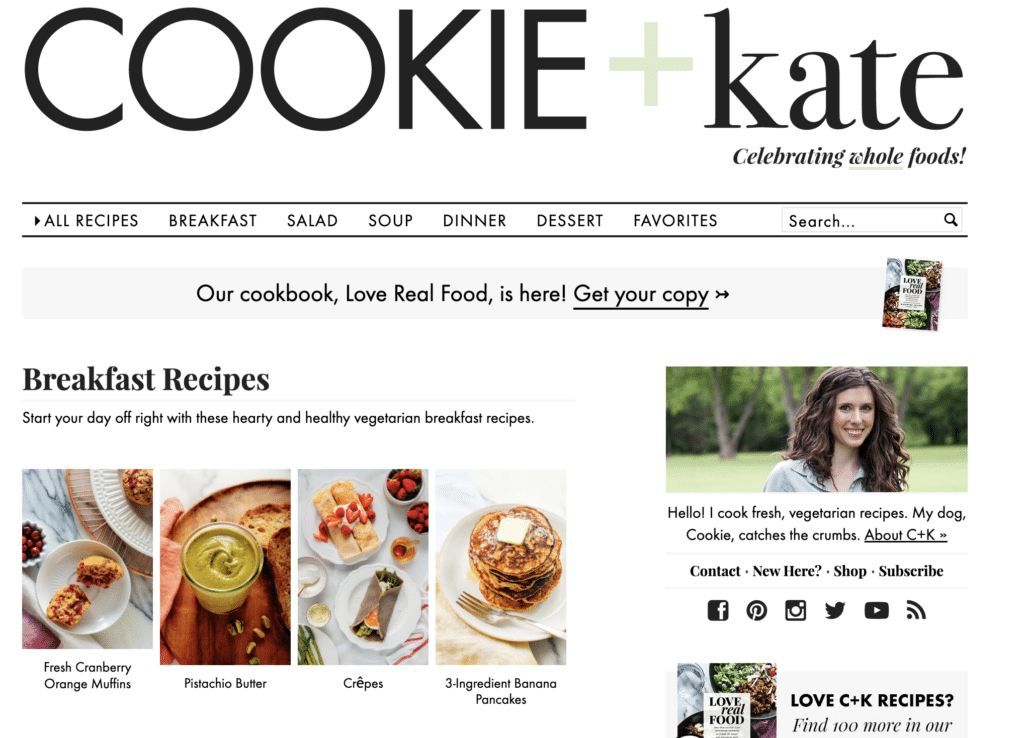Whether you’re a passionate home chef eager to share your culinary creations or a food enthusiast on the hunt for the next big flavor, becoming a food blogger can be your ticket to a vibrant online community and, potentially, a lucrative career.
But before you dive headfirst into the realm of food blogging, it’s essential to understand that this journey requires more than just a love for cooking and writing. Becoming a successful food blogger means wearing many hats – you’ll find yourself juggling roles as a chef, photographer, videographer, writer, content editor, digital marketer, and even customer support. It’s a multifaceted job requiring multitasking skills, energy, resources, and time.
If you’re ready to make room for this exciting commitment, you’re in the right place. This article will help you navigate through the initial stages of setting up your blog, engaging with your audience, and building a brand that resonates with food lovers around the globe.
Let’s dive in!
1. Plan your finances
Before you tackle the steps to become a food blogger, you need a budget to support it.
As a foodie and home cook, you know that cooking isn’t an inexpensive hobby. Specialty ingredients, quality equipment, and website costs add up.
But that’s not all. Starting a food blog involves its own set of expenses outside the kitchen. For example, you’ll need a reliable website to host your blog, which means budgeting for domain registration, hosting services, and perhaps a professional design to make your site as inviting as your recipes.
In addition, you’ll have to buy a solid camera to take those gorgeous and perfectly imperfect food shots. This means setting aside funds for a camera to do your culinary creations justice and any additional photography equipment, such as lenses, tripods, and lighting setups.
On average, you could expect to pay around $700 – $850 for everything you need to start a food blog. $100 will be spent on the basics, like the domain name, hosting service, and website builder, which we will cover in detail soon (please note that this amount was calculated assuming you pick WordPress as your website builder since it’s free except hosting.) The rest will be spent on the photography tools: Around $400 for a beginner professional camera, another $100 for a professional lens, and $100 – $150 for tripods and lighting setup.
2. Choose a niche
At first, it’s tempting to think that a general food blog with various recipes will be more successful. After all, you’d be targeting all sorts of foodies, so the potential for traffic is broader, right?
In practice, you’re unlikely to stand out without a Unique Selling Proposition (USP) that gives readers a specific reason to check out your website. The best approach is to pick a niche that suits your interests and skills to help your website stand out from the crowd.
The good news is that the food blogging world is large, and, in truth, there’s no shortage of options you can choose from. Some of the most popular food blogging niches include:
- Vegan food blogging
- Restaurant reviews
- Home baking websites
- Farm-to-table cooking
- Cooking on a budget
- Gluten-free recipes
- International cuisine blogs
- Healthy meals
- Smoothies
- Kid’s Recipes
- Coffee
- Food and travel
Selecting a clear and well-defined niche for your website will allow you to build authority, make it much easier to plan your content, and enhance audience engagement. For examples of well-defined websites, look at EAT MCR, which focuses on local restaurants and food culture in Manchester, and Cookie and Kate, which focuses on whole foods and vegetarian recipes.
3. Understand your audience
After choosing your niche, you should understand your audience and focus on your target readers rather than trying to cater to the entire world. Your chosen niche significantly determines the type of people you want to attract to your blog. Producing content that aligns with your target audience’s demographics, interests, and challenges is essential.
Here are some practical tips on defining your target audience:
- Create an ideal consumer persona, a fictional representation of your ideal visitor. This persona will guide you in making consumer-driven decisions and tailoring your content accordingly. For example, for a food and travel niche, it could be a remote worker who travels the world or upper-class individuals who like to spend their vacations in different countries.
- Identify the main players in your niche and review their followers, comments, and reviews. Find out what the dominant follower profile is.
- Learn how to use tools like Google Analytics, Facebook Insights, or Twitter Analytics to see who is interacting with your content.
After you identify a profile, you can search for trends and interests based on their demographics and start testing. The best approach to really understanding your audience would be to make educated guesses with your content and see how they react.
You can also engage with them directly to gain further insights into your website visitors. This includes reading and responding to blog comments, exploring social media interactions, and utilizing surveys. These interactions will provide valuable information about their needs and preferences.
Remember that understanding your audience is an ongoing process rather than a one-time action. It should continuously deepen, evolve, and progress.
4. Blog name and domain
Now that you know your niche and target audience, you can choose your blog and domain name. Your blog name should represent your chosen niche and content while being memorable. It’s essential to pick the right name first since rebranding will be complex once you start building an audience.
Various food blog names range from the direct to the cute and clever. When choosing your blog’s name, keep these three must-follow tips in mind:
- Make it catchy. It doesn’t have to be super creative, but it does have to be easy to remember and recall.
- Check that it doesn’t already exist as a blog name, domain name, or social media account. Aside from impeding on copyright- or trademark-related issues, you could also create unnecessary competition.
- Spell and punctuate it correctly! The last thing you want is a blog name with a typo.
When choosing a blog name, aim for brevity, catchiness, and simplicity in spelling. Avoid using hyphens or numbers that can confuse readers. For a food blog, names like “TastyBites,” “FoodieFeast,” or “FlavorfulKitchen” could work well, reflecting the essence of the niche and being easy to remember.
Before picking a domain name, let’s explain what a domain is. In simple terms, a domain name is your website’s online address. It’s how people find you among other online content. You can use an existing one or get a unique domain name for your blog.
Choosing a memorable name that reflects your blog’s theme and content is crucial. Therefore, the best practice would be to get a unique name because it brings numerous benefits to your food blog, like adding professionalism and credibility, making it easier for readers to trust your content. A custom domain enhances search engine rankings, increasing your blog’s visibility. Moreover, it allows you to have a custom email address, further establishing your brand identity. Having a custom domain provides complete control over your brand and online presence.
To register the domain name you want to use, you can visit domain registrars or hosting platforms like GoDaddy and NameCheap to see if it is available. If it is, you can register it to start using it. If not, you can choose a similar alternative that these platforms will suggest. You can also use domain name generators like DomainWheel for new ideas.
5. Choose a web host and website builder
Now, it’s finally time to start building your website; to do that, you must choose a hosting service provider first. A web host is the foundation of your web page and it stores all your blog’s data. When choosing a web host, make sure it is:
- Reliable: Accessible online almost always
- Large storage space: At least 10GB to store all your content safely
- Secure: It should be immune to errors, attacks, and malware as best as possible
- Scalable: Your web host plan should be able to scale up depending on your blog’s growth.
It is worth mentioning that some website builders, such as Squarespace, Wix, and Weebly, do not require a separate host platform. While this might seem like a benefit at first, it might offer very limited functionalities when building a website.
If you want to build your website with WordPress and enjoy its perks, like the large ecosystem of themes and plugins available, the first thing you should do is pick your host. You’re in charge of the payment systems you want to integrate, the functionality you want to add, etc. Hosting is an important consideration with WordPress, and we recommend A2 Hosting because it’s easy to use and offers a variety of different subscription options.
After choosing a hosting service, you need to pick a website builder to build your blog. A website builder is an online platform that provides you with everything you need to build and manage a website, from templates to customization options, without understanding coding or web development.
Getting started with a website builder is as simple as signing up for an account. Many website builders offer free plans or trials, allowing you to explore their features before committing to a paid subscription. Once you’ve chosen a builder, you can start customizing your site immediately, from selecting a template that matches your blog’s vibe to adding your first recipes and photos.
There are several popular website builders out there, each with its unique set of features and benefits. Here are a few top picks among food bloggers:
- WordPress: Known for its flexibility and a vast array of plugins, WordPress is a favorite for those who want more control over their site’s functionality and design. While it has a steeper learning curve, the possibilities are nearly limitless.
- Squarespace: Praised for its stunning, designer-quality templates and intuitive drag-and-drop interface, Squarespace is a go-to for bloggers who prioritize aesthetics and ease of use. However, the options for increasing and diversifying functionality can be limited since Squarespace doesn’t offer a rich selection of plugins.
- Wix: Wix offers a wide range of templates and a highly customizable editor, making it easy to bring your vision to life without touching a line of code. It’s also known for its robust app market, which allows you to add extra functionalities to your blog. However, all free templates feature the Wix logo, which might affect your blog’s personality.
- Weebly: Focusing on simplicity and user-friendliness, Weebly is a solid choice for those new to website building. It can support a beautiful food blog. However, customization options might be very limited.
Each platform offers solutions for aspiring food bloggers. However, it is worth noting that WordPress is the largest and most popular of them all. As of 2024, WordPress powers 43.3% of all websites on the Internet, growing by around 500 new websites daily.
WordPress is popular due to its simplicity, scalability, a rich selection of plugins focusing on food blogging niches, and detailed customization capabilities. For these reasons, It is a popular choice among food bloggers who want to tailor their blog to fit their preferences, expand its capabilities through additional plugins, and take advantage of the already large WordPress community.
6. Choose a theme
Once you’ve selected your website builder, choosing a theme for your food blog is the next exciting step. Your theme is the visual layout and design scheme of your site. It dictates how your content is presented and navigated, setting the tone for your blog’s overall aesthetic and user experience.
When choosing a theme for your blog, keep the following matters in mind:
- Reflect your blog’s personality: Your theme should mirror the essence of your blog. Whether rustic and cozy, modern and minimalist, or vibrant and eclectic, choose a theme that aligns with your content’s vibe.
- Functionality: Opt for a responsive theme (meaning it adjusts smoothly to different screen sizes, like mobile phones and tablets) that is easy to navigate and has a clean layout. Features like a recipe index, search bar, and social media integration can significantly enhance your readers’ experience.
- Speed and SEO-friendly: A theme heavy on graphics and complex features might slow down your site, affecting your blog’s search engine rankings and user satisfaction. Choose a theme optimized for fast loading times and built with the best SEO practices in mind to help your recipes rank higher in search results.
- Support and updates: Ensure your chosen theme is well-supported by its developers. Regular updates and reliable support can protect your site from security vulnerabilities and ensure it stays compatible with the latest web updates.
7. Add dedicated plugins
After you choose your blog name, domain name, website builder, and theme, you’re all set. However, we can give you a few more tips to help you stand out amongst other basic food blogs.
Once you’ve chosen a theme for your food blog, it’s time to enhance its functionality with dedicated plugins. They add specific features or functionalities to your website without the need for custom coding. Plugins are easy to install and manage from your website’s dashboard, allowing for straightforward customization and enhancement of your blog’s functionality. While some plugins may come with your theme, niche ones like those for recipes probably won’t. That’s where a tool like WP Recipe Maker comes in. This plugin is specifically designed to address the needs of food bloggers in a way that even rookies can easily use. It allows you to easily create recipes complete with ingredients, instructions, and nutritional information to post on your blog.
8. Create a content plan
Another important tip we can give you is to create a content plan before posting content. A well-structured content plan will be the backbone of your blogging journey, enabling you to maintain consistency, capitalize on trends, and continually offer value to your readers.
To create a content plan, you can start with a brainstorming session to generate various food content ideas. Think about the types of dishes, cooking tips, ingredient deep-dives, or culinary trends that excite you and would resonate with your audience.
Once you have a pool of ideas, it’s time to organize them into a publishing schedule. This calendar should detail what content you’ll post and when considering the best times to reach your audience. The best time to publish content will depend on your niche. However, weekday afternoons are usually the most busy times to post a new food recipe. Also, when planning, make sure to consider seasonal trends and holidays.
All that is left for you to do is follow your plan. Project management tools like Nifty can streamline the planning process, keeping all your ideas, schedules, and tasks in one place and making following your schedule more manageable.
9. Last warning before publishing
Getting all of your ducks in a line regarding your website is great, but one thing you can’t forget about is content. The last thing you want is to publish an empty blog, right?
Wrong. Most newbie blog owners would assume publishing an empty blog damages user experience. You can gather a few recipes and pictures and publish them in one day, and then edit the dates to make it look like the blog has been live for a while. However, this would be a crucial mistake that would negatively affect your blog’s SEO, resulting in your content ranking lower.
There is no shame in starting a blog from scratch. You can even turn an empty blog into an advantage by launching promotions or publishing special content for early adapters who discovered your blog so soon. So, don’t worry about starting with an empty blog; focus on producing constant, good-quality content and start building your brand.
Since you’ll be putting out great (and yummy) content regularly, you’ll gain visibility, which you can further enhance by leveraging your existing network.
Wrapping up
Your journey as a food blogger combines passion, planning, and perseverance. It begins with a solid financial plan, choosing your domain, selecting the right website builder, and picking a theme that speaks to your readers.
Then, you can take the extra steps by creating a content plan and enriching your theme with various plugins. Creating a content plan will ensure your productivity and punctuality. In contrast, food blog-dedicated plugins like WP Recipe Maker will enhance your blog capabilities and make a real difference between your content and others.
With WP Recipe Maker, you can create detailed recipes that appeal to your visitors and search engines and organize them based on different filters, such as cuisine, cooking methods, ingredients, dietary choices, and more. Your readers enjoy easy navigation among your recipes without you having to spend hours organizing them.
Begin today, and let WP Recipe Maker help you present your culinary masterpieces to the world.








